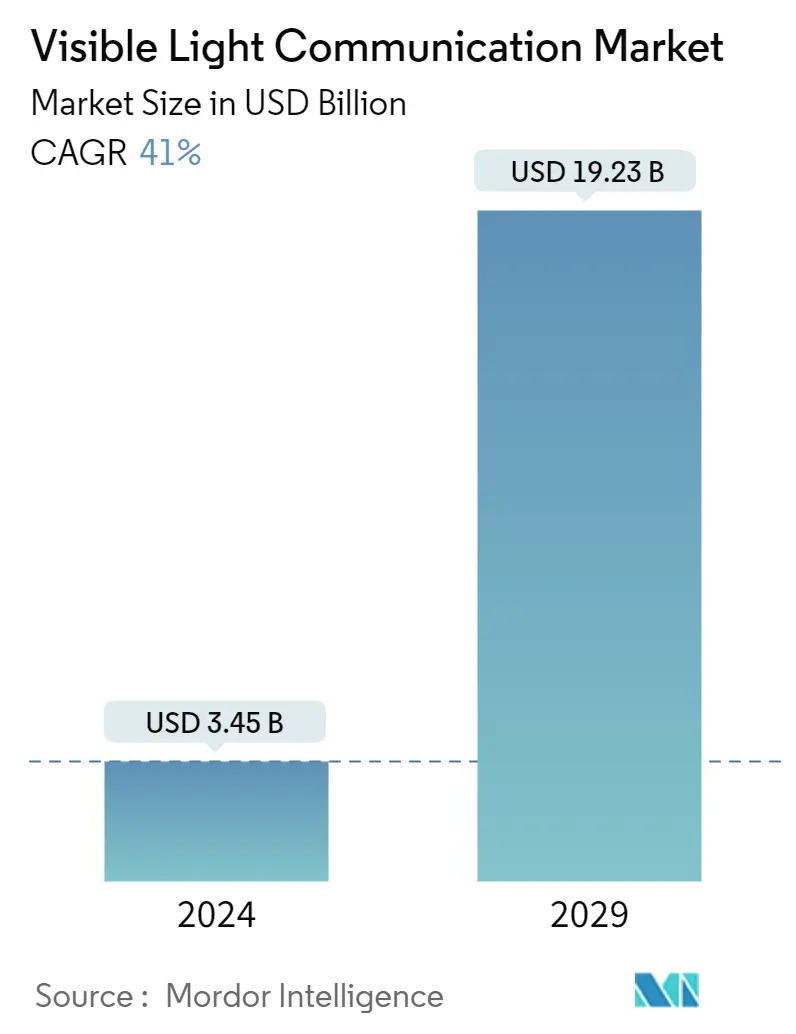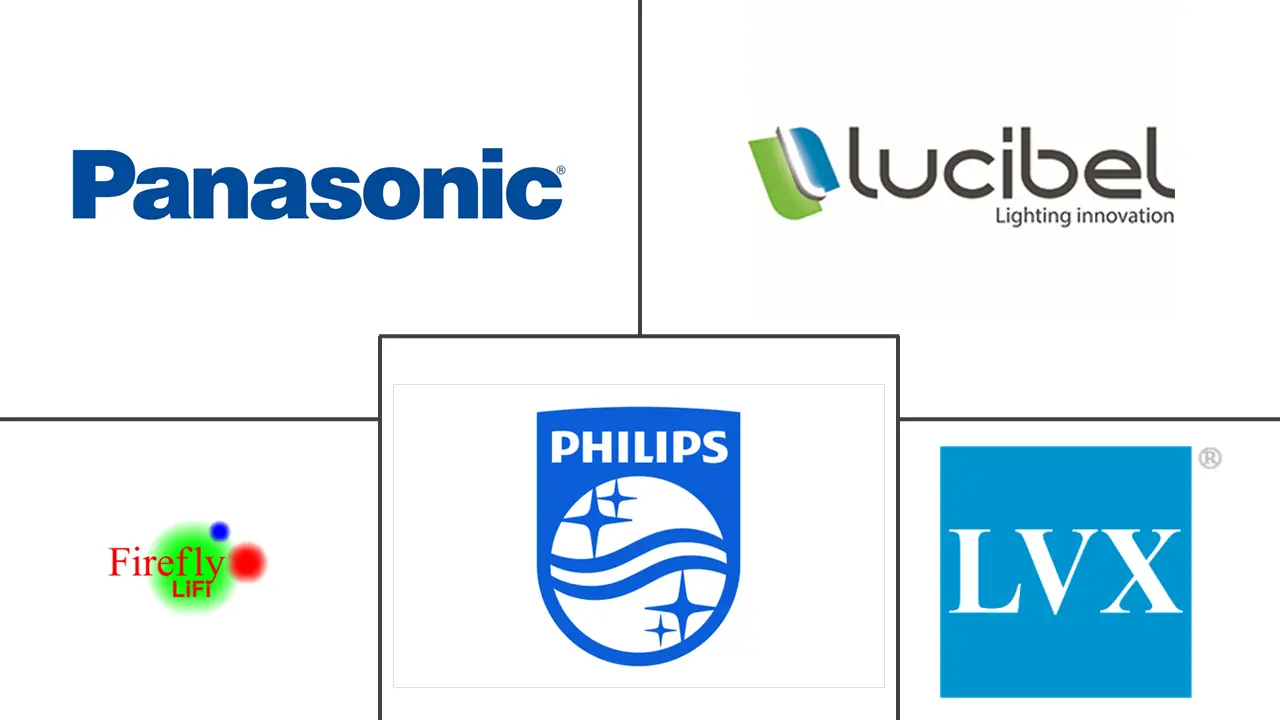Market Size of Visible Light Communication Industry

| Study Period | 2019 - 2029 |
| Market Size (2024) | USD 3.45 Billion |
| Market Size (2029) | USD 19.23 Billion |
| CAGR (2024 - 2029) | 41.00 % |
| Fastest Growing Market | Asia-Pacific |
| Largest Market | North America |
Major Players
*Disclaimer: Major Players sorted in no particular order |
Visible Light Communication (VLC) Market Analysis
The Visible Light Communication Market size is estimated at USD 3.45 billion in 2024, and is expected to reach USD 19.23 billion by 2029, growing at a CAGR of 41% during the forecast period (2024-2029).
The global visible light communication market is valued at USD 1.8 billion in the current year and is expected to register a CAGR of 40.1% during the forecast period, reaching USD 19.3 billion by the end of the forecast period. The need for high-speed data transfer, data security, an imminent RF spectrum constraint, and various technological advantages over Wi-Fi technology primarily drives the market for visible light communication. Besides being more cost-effective, Li-Fi has various advantages over current Wi-Fi technology, including roughly 100 times quicker data transfer speed, greater data security, no electromagnetic interference, and lower power usage.
- However, the limited range of communication limits Li-Fi's application because it works best in a closed control environment, and the presence of other light sources slows its performance. Nonetheless, substantial research in this field is expected to drive future demand in the light fidelity (Li-Fi) market.
- VLC can be particularly useful for Internet of Things (IoT) devices as it enables reliable and secure communication in environments where other wireless technologies, such as Wi-Fi, Bluetooth, or Zigbee, can be subject to interference. Moreover, VLC provides an added layer of security as light cannot penetrate walls, preventing eavesdropping and unauthorized access. Some examples of how VLC can be used in IoT applications include enabling battery-free duplex communication for IoT devices, initialization and bootstrapping of secure communication between wireless devices, and enhancing indoor IoT communication with visible light and infrared technology.
- Moreover, by 2023, there will likely be close to 30 billion network-connected devices and connections, an increase from 18.4 billion in 2018, according to Cisco's Annual Internet Report predictions. By 2023, IoT devices would make up 50% (14.7 billion) of all networked devices, up from 33% (6.1 billion) in 2018. Such a huge rise in IOT devices would drive the studied market.
- The players in the market are collaborating to cater to consumers' evolving and complex requirements. For instance, in June 2022, Situm collaborated with ZERO1 to create indoor navigation systems based on visible light communication technologies. Situm has specialized in providing exact indoor location and navigation without needing dedicated infrastructure (through Wi-Fi) or, in some situations, with the fewest BLE beacons. OCC and VLC technologies, in which French company ZERO1 specializes, employ LED installations - which are already present in many buildings - and cellphones to locate indoors precisely. The combination of these two technologies is expected to provide ultra-high dependability and an unprecedented user experience for shopping malls, airports, hospitals, factories, and other large indoor spaces, as well as the new potential for businesses to present their points of interest throughout these huge indoor spaces.
- On the flip side, visible Light Communication (VLC) has several challenges that must be addressed for widespread adoption. VLC has a limited range compared to radio frequency (RF), which can limit its usability in some applications. VLC requires a line-of-sight connection between the transmitter and receiver, which can limit its usability in some applications. VLC can experience interference from other environmental light sources, such as sunlight or fluorescent lights. Factors like these can hinder the studied market.
- A key macroeconomic growth driver of the VLC market is the increasing digitization worldwide. For instance, the increased focus of the Indian government on creating a digitally empowered economy is expected to benefit the market, with core digital sectors such as information technology and business process management, digital communication services, and electronics manufacturing expected to double their GDPs to USD 355-435 billion by 2025. A growing number of smartphones, laptops, and other devices are now equipped with VLC receivers, making it easier for businesses and consumers to adopt VLC solutions.
Visible Light Communication (VLC) Industry Segmentation
Visible Light Communication(VLC) systems are being developed to create ultra-high-speed, secure, and biologically friendly communication networks that allow the creation and expansion of seamless computing applications. Such systems use modulated light wavelengths emitted by a variety of suitably adapted conventional sources, such as outdoor and indoor lighting, illuminated signs, displays, televisions, computer screens, digital cameras, and digital cameras on mobile phones for communication purposes, majorly through the use of Light Emitting Diodes (LEDs).
The Visible Light Communication Market is segmented by Component (LED, Photodetectors, Microcontrollers, Software & Services), Transmission Type (Uni-directional, Bi-directional), Application (Consumer Electronics, Defense & Security, Transportation, Public Infrastructure, Life Sciences), and Geography (North America, Europe, Asia-Pacific, Latin America, Middle East and Africa). The market sizes and forecasts are provided in terms of value (USD) for all the above segments.
| By Component | |
| Light Emitting Diodes | |
| Photodetectors | |
| Microcontrollers | |
| Software and Services |
| By Transmission Type | |
| Uni-directional | |
| Bi-directional |
| By Application | |
| Consumer Electronics | |
| Defense and Security | |
| Transportation | |
| Public Infrastructure | |
| Life Sciences | |
| Other Applications |
| By Geography | |||||||
| |||||||
| |||||||
| |||||||
| |||||||
|
Visible Light Communication Market Size Summary
The Visible Light Communication (VLC) market is poised for significant growth, driven by the increasing demand for high-speed data transfer and enhanced security features. VLC, particularly through its Li-Fi technology, offers advantages over traditional Wi-Fi, such as faster data transfer speeds, reduced electromagnetic interference, and lower power consumption. These benefits make VLC an attractive alternative for applications requiring secure and rapid communication, especially in environments where radio frequency spectrum is constrained. The technology's potential is further amplified by its compatibility with Internet of Things (IoT) devices, providing reliable communication in settings where other wireless technologies may face interference. Despite challenges like limited range and susceptibility to environmental light interference, ongoing research and technological advancements are expected to bolster the market's expansion.
The market landscape is characterized by moderate competition, with key players like Koninklijke Philips, LVX System, and Panasonic Corporation actively developing and deploying VLC technologies. Innovations such as pureLiFi's Light Antenna ONE and Oledcomm's LIFIMAX2G highlight the industry's focus on enhancing VLC capabilities for consumer electronics and smart home applications. The growing adoption of smart devices and the increasing digitization of economies worldwide are significant macroeconomic drivers for the VLC market. Additionally, the integration of VLC in sectors like autonomous vehicles and smart city infrastructure presents new opportunities for market growth. As VLC technology continues to evolve, it is expected to play a crucial role in the future of wireless communication, offering a sustainable and efficient alternative to existing technologies.
Visible Light Communication Market Size - Table of Contents
-
1. MARKET INSIGHTS
-
1.1 Market Overview
-
1.2 Industry Attractiveness - Porter's Five Forces Analysis
-
1.2.1 Bargaining Power of Suppliers
-
1.2.2 Bargaining Power of Buyers
-
1.2.3 Threat of New Entrants
-
1.2.4 Threat of Substitute Products
-
1.2.5 Intensity of Competitive Rivalry
-
-
1.3 Value Chain Analysis
-
1.4 Assessment of Impact of Macro Economic Trends on the Industry
-
-
2. MARKET SEGMENTATION
-
2.1 By Component
-
2.1.1 Light Emitting Diodes
-
2.1.2 Photodetectors
-
2.1.3 Microcontrollers
-
2.1.4 Software and Services
-
-
2.2 By Transmission Type
-
2.2.1 Uni-directional
-
2.2.2 Bi-directional
-
-
2.3 By Application
-
2.3.1 Consumer Electronics
-
2.3.2 Defense and Security
-
2.3.3 Transportation
-
2.3.4 Public Infrastructure
-
2.3.5 Life Sciences
-
2.3.6 Other Applications
-
-
2.4 By Geography
-
2.4.1 North America
-
2.4.1.1 United States
-
2.4.1.2 Canada
-
-
2.4.2 Europe
-
2.4.2.1 United Kingdom
-
2.4.2.2 Germany
-
2.4.2.3 Rest of Europe
-
-
2.4.3 Asia-Pacific
-
2.4.3.1 China
-
2.4.3.2 South Korea
-
2.4.3.3 India
-
2.4.3.4 Japan
-
2.4.3.5 Rest of Asia-Pacific
-
-
2.4.4 Latin America
-
2.4.4.1 Brazil
-
2.4.4.2 Mexico
-
2.4.4.3 Rest of Latin America
-
-
2.4.5 Middle East and Africa
-
2.4.5.1 United Arab Emirates
-
2.4.5.2 Saudi Arabia
-
2.4.5.3 Rest of Middle East and Africa
-
-
-
Visible Light Communication Market Size FAQs
How big is the Visible Light Communication Market?
The Visible Light Communication Market size is expected to reach USD 3.45 billion in 2024 and grow at a CAGR of 41% to reach USD 19.23 billion by 2029.
What is the current Visible Light Communication Market size?
In 2024, the Visible Light Communication Market size is expected to reach USD 3.45 billion.

